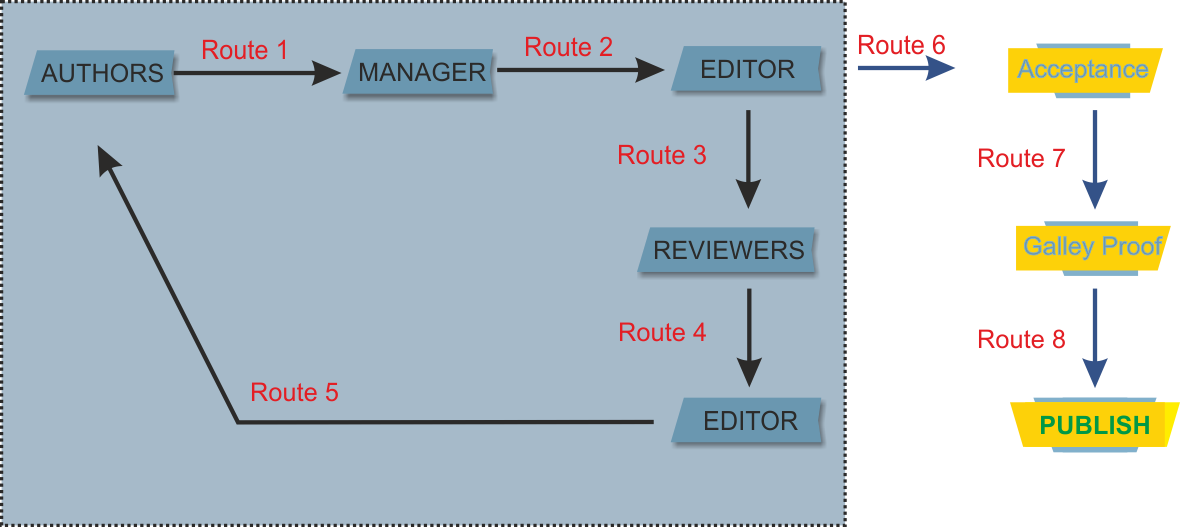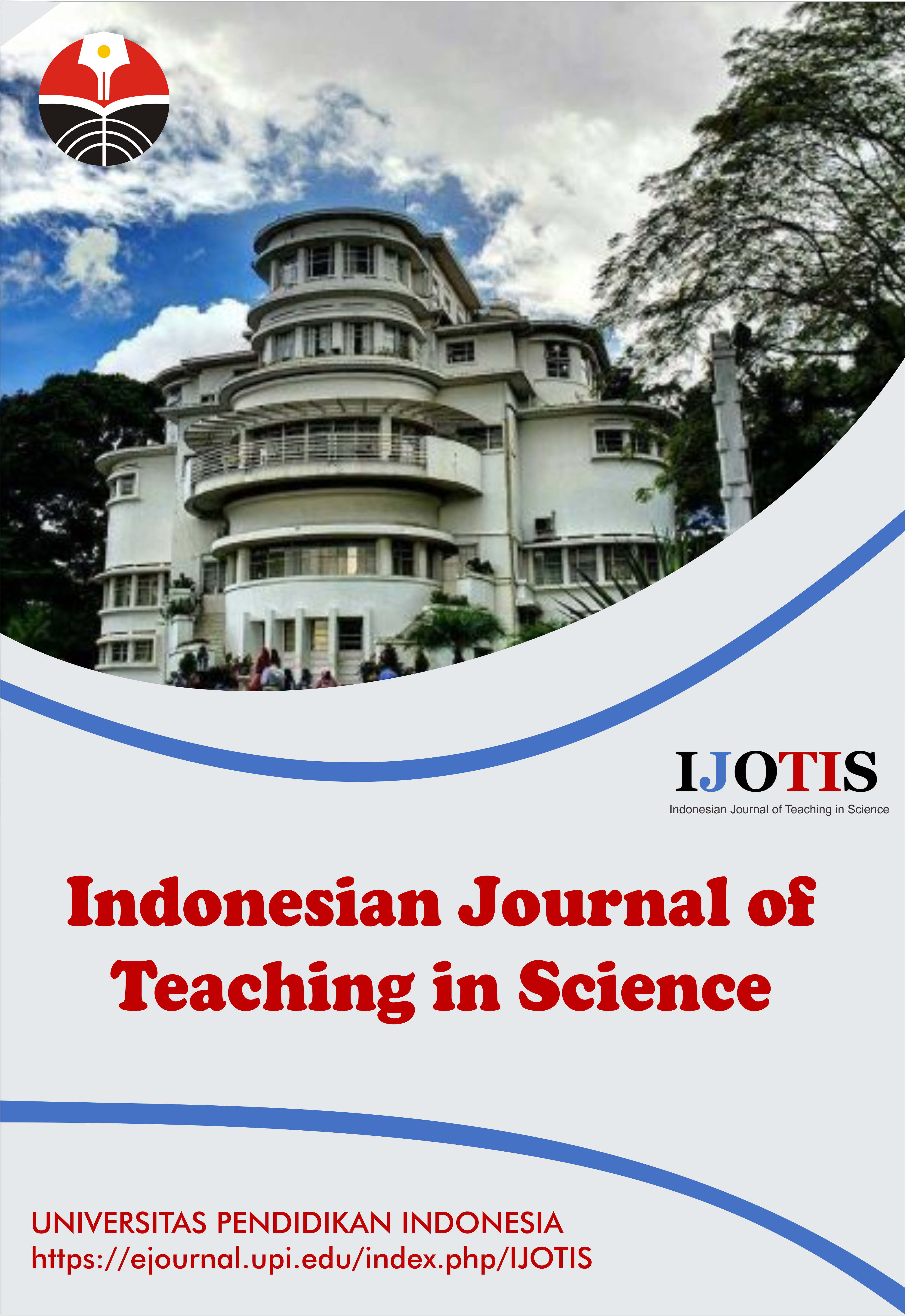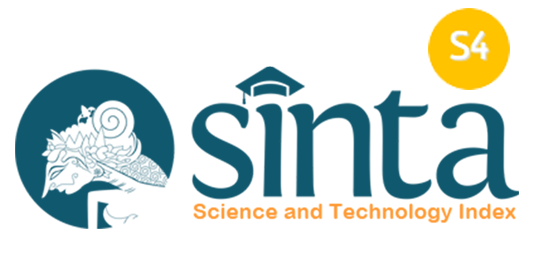- Focus and Scope
- Section Policies
- Peer Review Process
- Publication Frequency
- Open Access Policy
- Archiving
- Plagiarism Screening
- Publication Ethics Statement
- Licensing
- Fees
Focus and Scope
Indonesian Journal of Teaching in Science (IJoTIS) promotes research in the broad field of science and Engineering Education (including such disciplines as Agriculture Education, Environmental Science Education, etc.) with particular respect to Indonesia, but not limited to authorship or topical coverage within the region.
Contributions are expected from senior researchers, project managers, research administrators and PhD students at advanced stages of their research, representing both public organizations and private industry. Equally, the journal if intended for scholars and students, reseachers working at research organizations and government agencies, and also for enterprises undertaking applied R&D to lead innovations.
The editorial contents and elements that comprise the journal include:
- Theoretical articles
- Empirical studies
- Practice-oriented papers
- Case studies
- Review of papers, books, and resources.
As far as the criteria for evaluating and accepting submissions is concerned, a rigorous review process will be used. Submitted papers will, prior to the formal review, be screened so as to ensure their suitability and adequacy to the journal. In addition, an initial quality control will be performed, so as to ensure matters such as language, style of references and others, comply with the journal´s style.
The below mentioned areas are just indicative. The editorial board also welcomes innovative articles that redefine any Science and Technology field.
- Chemistry and Chemical Engineering Education
- Physics, Material, and Mechanical Engineering Education
- Biology, Biological and Bio System Engineering Education
- Food and Agriculture Engineering Education
- Mathematics Education
- Computer Science and Engineering Education
- Earth Science and Engineering Education
- Space Engineering Education
- Electrical Engineering Education
- Architecture and Civil Engineering Education
- Environment Science and Engineering Education
- Basic Science in Engineering Education
- Engineering Education Reforms Education
- New Technologies in Education
- Industry and Education: A Continous Collaboration Education
- Research and Development in Engineering Education
- Globalisation in Engineering Education
- Women in Engineering Education
- Computers, Internet, Multimedia in Engineering Education
- Organization of Laboratories Education
- Agricultural Bio Systems Engineering Education
- Mechanical Engineering Education
- Electric and Electronic Engineering Education
- Civil Engineering and Architectural Engineering Education
Section Policies
Articles
Peer Review Process
All papers are fully peer-reviewed. We only publish articles that have been reviewed and approved by highly qualified researchers with expertise in a field appropriate (at least two reviewers per article). We used blind peer-reviewing process. Detailed information about the flow for the manuscript submission (author) to the acceptance by editor is shown in the following figure.

In short, the steps are:
- Manuscript Submission (by author) (route 1)
- Manuscript Check and Selection (by manager and editors) (route 2). Editors have a right to directly accept, reject, or review. Prior to further processing steps, plagiarism check using turtitin is applied for each manuscript.
- Manuscript Reviewing Process (by reviewers) (route 3-4)
- Notification of Manuscript Acceptance, Revision, or Rejection (by editor to author based on reviewers comments) (route 5)
- Paper Revision (by author)
- Revision Submission based on Reviewer Suggestion (by author) with similar flow to point number 1. (route 1)
- If reviewer seems to be satisfied with revision, notification for acceptance (by editor). (route 6)
- Galley proof and publishing process (route 7 and 8)
The steps point number 1 to 5 is considered as 1 round of peer-reviewing process (see grey area in the figure). And, our reviewing process at least goes through 2 round of reviewing process.
The journal editor or editorial board considers the feedback provided by the peer reviewers and arrives at a decision. The following are the most common decisions:
(i) accept without any changes (acceptance): the journal will publish the paper in its original form
(ii) accept with minor revisions (acceptance): the journal will publish the paper and asks the author to make small corrections
(iii) accept after major revisions (conditional acceptance ): the journal will publish the paper provided the authors make the changes suggested by the reviewers and/or editors
(iv)revise and resubmit (conditional rejection): the journal is willing to reconsider the paper in another round of decision making after the authors make major changes
reject the paper (outright rejection): the journal will not publish the paper or reconsider it even if the authors make major revisions
Publication Frequency
This journal will be published two times a year on the following months: March and September. Every issue consist of about 10 articles and therefore every volume has about 20 articles/reviews.
Open Access Policy
This journal provides immediate open access to its content on the principle that making research freely available to the public supports a greater global exchange of knowledge.
The published articles are licensed under the Creative Commons Attribution-ShareAlike 4.0 International License.
Archiving
This journal utilizes the LOCKSS system to create a distributed archiving system among participating libraries and permits those libraries to create permanent archives of the journal for purposes of preservation and restoration. More...
Plagiarism Screening
Before going to review process, all manuscripts will be checked that they are free from plagiarism practice (less than 20% similarities). If there an indication of plagiarism (higher than 20% similarities), the manuscript will instantly be rejected.
Publication Ethics Statement
ETHICS AND MALPRACTICE STATEMENT
(Based on Committee on Publication Ethics (COPE) (see https://publicationethics.org/) and the World Association of Medical Editors (WAME) (see https://wame.org/) in the Best Practice Guidelines for Journal Publication Process).
Ethical guidelines for the journal publication
----------------------------------------------------------
In the peer-reviewed journals published by Universitas Pendidikan Indonesia, the publication of an article is process of permanent knowledge improvement. The article must be supported by scientific method that embedded in the text. This can reflect the quality of the work of the authors and the institutions that support them. The article must be agreed upon standards of expected ethical behavior for all parties, including the author, the journal editor, the peer reviewers, and the publisher as well as sponsored journals.
Articles published in our journals in Universitas Pendidikan Indonesia are for advancement of ongoing research from current knowledge and theories. All articles are produced and must be agreed to follow ethical behavior from all parties involved in the publication process, including authors, editors, reviewers, and publishers, as well as sponsored papers and journals.
Our publications pledge to make sure that editorial decisions are unaffected by advertising, reprints, or other commercial revenue. Additionally, where it is beneficial to editors, the Editorial Board will help in discussions with other journals and/or publishers.
AUTHOR(S)’S DUTIES
Authors have several duties based on Committee on Publication Ethics (COPE) (see https://publicationethics.org/) and the World Association of Medical Editors (WAME) (see https://wame.org/):
- Scientific report submitted by authors. The authors must report on original research, which ought to give a truthful summary of the work that has been done with an unbiased analysis and relevance. The report should appropriately depict the underlying data, having enough information and citations to let someone else duplicate the work. False or deliberately inaccurate statements are inappropriate, and they can represent unethical behavior. Data must be truthful, unbiased, accurate, and objective.
- Data protection and availability. The raw data related to the article submitted by author may be requested for editorial review. If possible, authors should be ready to make these data accessible to the public. In any case, they should be ready to keep these data for a fair amount of time after publication. Authors can ask data submitted to be accessible or not to the public, and this can be discussed with editors; and this must be confirmed during reviewing process.
- Submission of article against plagiarism and originality. The authors should make sure that their writing is unique and original. In the case that authors need to borrow any ideas or words from other papers, they should make sure that they have properly cited or quoted them. Plagiarism is unacceptable in all forms since it is unethical behavior in scientific publication. There are many types of plagiarism, such as 'passing off' another person's paper as the author's own paper, copying or paraphrasing significant portions of another paper without giving credit/citation, or claiming the findings of research that was undertaken by someone else.
- Authorship (who must be included in the article). The authors are only individuals who significantly contributed to the conception, design, implementation, or interpretation of the reported study. There are first author (that is positioned in the first position in the authors’ list), co-authors (other authors put after the first author), and corresponding author (author(s) with asterix and email information). All authors must agree to the paper's submission for publication.
- Recognition and Acknowledgements. All recognitions and acknowledgments must be added in the acknowledgment section in the article. The authors must give credit/thank to other people's contributions, giving private information, conversations, letters, or discussions, citations for works that had a significant impact on understanding the reported work, grant applications, and institutions that support the research and article.
- Conflicts of interest. Any financial or other significant conflict of interest (including author-author conflict of interest) that could be taken to have an impact on the findings or interpretation of a manuscript should be disclosed by all authors in the publication. At the earliest submission, such conflicts of interest must be clarified and the information must be put in the article.
- Basic mistakes and fundamental errors in the published works. It is the responsibility of the authors to contact the editor as soon as when a serious error or inaccuracy in the author's own published work is found. The authors must work with the editor to retract or fix the manuscript.
- Publication with contemporaneous, multiple types, duplication, redundancy. It is unacceptable to simultaneously submit the same article to multiple journals, which is considered unethical publishing behavior. Indeed, the authors should not submit an article that has already been published for consideration in another publication journal(s). If authors add other results from their previous work or another paper, they have to inform as citation in the submitted article.
EDITOR(S)’S DUTIES
Editors have several duties based on Committee on Publication Ethics (COPE) (see https://publicationethics.org/) and the World Association of Medical Editors (WAME) (see https://wame.org/):
- Publication decisions. Editor(s) has a right to take decision whether the article is accepted/published or not. The first result is based on editor’s decision. If the article passes the first editor decision, it goes to the second result guided by the decision of reviewers. Editors collect, compile, and decide from reviewers’ comments. Several points can be used to take decision by editor: the policies of the journal's editorial board such as focus and scope, novelties, legal requirements, libel, copyright infringement, and plagiarism.
- Fair play and confidentiality in taking care article. All articles received by editors must be taken care without author(s)'s race, gender, sexual orientation, religion, ethnicity, citizenship, or political philosophies. All data during the reviewing and editing processes must be taken confidentially. Editors and journal’s staff must not share and disclose any information about the article that submitted to the journal to other people, except authors, reviewers, potential reviewers, other editorial advisers, and the publisher.
- Conflicts of interest. Without the author's clear written approval, including peer-review-derived sensitive information and ideas, the editor may not use disclosed unpublished materials for their research. Editors should abstain from reviewing and evaluating manuscripts when they have conflicts of interest resulting from cooperative or other relationships or connections with any of the authors, businesses, or institutions; thus, the editor must ask co-editor, associate editor, or other editors to review and consider the manuscript. The authors should complete any pertinent competing interests, including publishing revisions if there are any discovered after the article has been published. If required, the action must be adopted, such as a publication.
- Complaints and investigations. When there is a complaint regarding ethical concerns raised on the submitted or published article, the editor should work with the publisher to take reasonable action, such as revision, correction, retraction, expression of concern, and other notes that are relevant. However, all actions must be done by additional confirmations and communications with authors to take action fairly.
REVIEWER(S)’S DUTIES
Reviewers have several duties based on Committee on Publication Ethics (COPE) (see https://publicationethics.org/) and the World Association of Medical Editors (WAME) (see https://wame.org/):
- Roles, Promptness, Confidentiality, and Fair Play Process in Reviewing. The reviewers help editors in giving judgments fairly without personal critism, suggestions/ideas to improve article qualities via peer reviewing process. Communication is only done between the reviewers and the editors, and there is no communication between the reviewer and the authors. All communications must be done via a formal scholarly communication in a time manner. If reviewer feels to be unqualified for reviewing the article, reviewer must inform and notify editor as soon as possible. Reviewers just give suggestion, while the final decision for the publication is on Editor. Article and all peer reviewing processing documents are confidential. The reviewer cannot discuss with authors or anybody without editor's permission.
- Acknowledgment. The reviewer should point out pertinent published works that the authors have not cited, giving ideas and claims based on a certain observation, deduction, or argument. The reviewer also informs and notice for any significant overlap or resemblance between article under consideration and any other published material based on reviewer’s knowledge.
- Conflict of interest. Without the author's express written authorization and editor’s permission, the reviewer may not use any unpublished materials disclosed in a submitted manuscript for their work. All peer review process is privileged knowledge. Thus, ideas must be kept secret and confidential, as well as not used for the reviewer’s benefit. Reviewers should not take into account in the reviewing process when they have relationships or links with any of the authors, organizations, or businesses associated with the articles.
Licensing

IJOTIS is licensed under a Creative Commons Attribution-ShareAlike 4.0 International License.
Fees
 Indonesian Journal of Teaching in Science
Indonesian Journal of Teaching in Science



